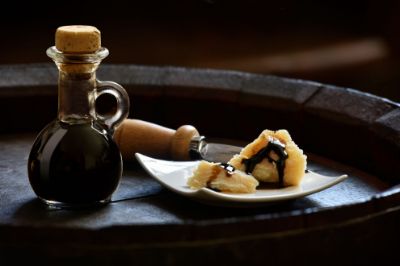Balsamic vinegar is a traditional Italian condiment that has been produced for hundreds of years. This flavorful vinegar is made by fermenting grapes and then aging the resulting liquid in barrels made of wood. While the process may seem simple, it is actually quite complex and requires a great deal of skill and patience.
The first step in making balsamic vinegar is to harvest the grapes. Traditional balsamic vinegar is made from the Trebbiano grape, although other varieties can be used as well. The grapes are then pressed to extract their juice, which is called must. The must is then cooked over low heat to concentrate the flavors and caramelize the sugars.
Once the must has been cooked down, it is then placed into wooden barrels to begin the aging process. Balsamic vinegar must be aged for a minimum of 12 years in order to be considered traditional balsamic vinegar. During this time, the vinegar is stored in a series of barrels that are made from different types of wood, including oak, chestnut, cherry, and juniper.
The process of aging balsamic vinegar in barrels is what gives it its unique flavor and complexity. As the vinegar ages, it absorbs the flavors of the wood, as well as the flavors of the vinegars that were previously stored in the barrels. This creates a rich and complex flavor that is not found in other types of vinegar.
To make balsamic vinegar in barrels at home, you will need to start by purchasing a high-quality barrel. Look for a barrel that is made from a combination of different woods, as this will give your vinegar a more complex flavor profile. You will also need to purchase high-quality grapes and a good-quality red wine vinegar to use as a starter culture.
Once you have your barrel, grapes, and starter culture, you can begin the process of making your own balsamic vinegar. Start by pressing the grapes to extract the must, and then cook the must down over low heat until it has been reduced by half. Next, transfer the must to your barrel and add in the red wine vinegar starter culture. Seal the barrel and place it in a cool, dark place to begin the aging process.
Over time, you will need to transfer the vinegar to different barrels in order to expose it to different types of wood. This will help to develop its unique flavor and character. After 12 years of aging, your balsamic vinegar will be ready to use in your favorite recipes or to give as a thoughtful and unique gift.
In conclusion, making balsamic vinegar in barrels is a time-honored tradition that requires patience, skill, and a commitment to quality. While it may take years to produce a high-quality vinegar, the end result is a flavorful and complex condiment that is sure to impress even the most discerning palates. If you are up for the challenge, consider trying your hand at making balsamic vinegar in barrels at home!


